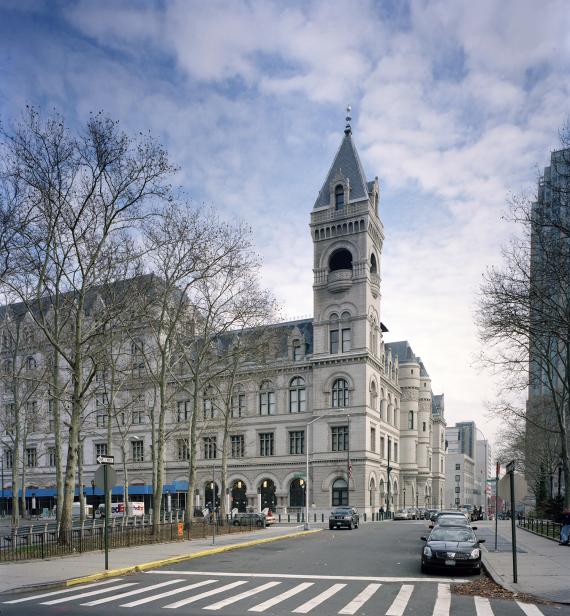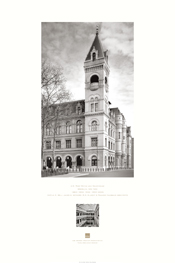Location: 301 Cadman Plaza E, Brooklyn, NY 11201
History
Dutch settlers founded Brooklyn in 1645. The village was sparsely populated until 1814, when Robert Fulton’s steam ferry first offered a means of commute to Manhattan. Brooklyn Heights became Manhattan’s first suburb, and downtown Brooklyn transformed into a thriving commercial district. When the Brooklyn Bridge was completed in 1883, residents were afforded another easy way to travel to Manhattan. As the population of Brooklyn grew, residents required a post office to handle the increasing volume of mail.
Planning and design for the new post office began in 1885. Mifflin E. Bell, supervising architect of the U.S. Treasury Department, designed the building in the Romanesque Revival style of architecture, which was commonly used for public buildings at that time. The building originally functioned as both a post office and courthouse with four courtrooms.
Much of the original appropriation for the building was allotted for the purchase of the lot, which is bounded by Cadman Plaza East, Johnson, Adams, and Tillary streets. Therefore, some of the more elaborate architectural details of Bell’s original design, such as larger corner towers, were never executed. Construction was completed in 1891; interior spaces were finished in 1892 and the building was occupied. Shortly thereafter, three passenger elevators and a mail lift were installed.
As the population continued to grow, officials determined more space was needed. Because the original building only occupied the southern half of the lot, the addition extended to the north. In 1933, James A. Wetmore, acting supervising architect of the U.S. Treasury Department, designed a compatible addition in a similar style. Two new courtrooms were added as part of the expansion.
The U.S. General Post Office was designated by the New York City Landmarks Preservation Commission in 1966 and listed in the National Register of Historic Places in 1974. In 1999 the U.S. General Services Administration (GSA) purchased the building and began extensive renovations that included the addition of new courtrooms and the restoration of historic courtrooms, original windows, numerous site features, and interior and exterior materials. It now houses postal services as well as the U.S. Bankruptcy Court, the U.S. Trustee, and the Offices of the U.S. Attorney.
Architecture
The U.S. Post Office and Courthouse in Brooklyn, New York, is an excellent example of Romanesque Revival architecture and is a prominent component of the Municipal Center complex. The original portion of the building is four stories in height and the 1933 addition is seven stories tall. The exterior has remained largely unchanged over time. The lively design of the building contains many character-defining features of the Romanesque Revival style. The central structure contains strong, simple forms with powerful arches dominating the first story. Elaborate dormers, iron roof cresting, steeply pitched roofs, and a tower give the building a picturesque quality.
The exterior of the building is rich in material, texture, form, and ornament. Semi-circular projections called tourelles protrude from the building. Each level is articulated in a slightly different way and distinguished by belt courses that encircle the building. Round arches of polished granite, which feature rosettes and cable moldings, dominate the first story. The arches spring from carved posts with foliated motifs. Rectangular windows surrounded by contrasting trim are on the second floor, while round-arch openings are on the third floor. The fourth story contains steeply pitched dormers with round-arch windows. A slate-covered mansard roof is topped with ornamental ironwork cresting.
The square corner tower rises above the roofline of the original building. Arched openings with semi-circular balconies are topped by an ornate cornice surmounted by a steeply pitched pyramidal roof.
One of the most significant interior spaces is the atrium. It is located in the center of the 1892 portion of the building and extends from the second to fourth floors. The atrium is enclosed by a three-level loggia. Each level of the loggia is supported by cast-iron columns that are adorned with acanthus and anthemion leaf motifs.
The main staircase is in the northeast corner of the original building. A decorative cast-iron balustrade with lantern-style newel posts encases soapstone treads. The stairwell walls are clad in mahogany Tennessee marble wainscot, and the floors are covered with black and white marble tiles laid on the diagonal.
The walls of the 1892 courtrooms are also covered with mahogany Tennessee marble wainscot with black soap-stone bands with a marble bead. Large round-arch windows have carved wood mullions and are operated by cast-metal pulls with griffin-head motifs. One of the courtrooms contains a marble and soapstone fireplace, which has a carved leaf pattern and marble mantel. Fireplaces are also in some of the original office spaces.
Some interior spaces have been altered over time. During World War II, a skylight and laylight that originally illuminated the postal work floor were covered to comply with black-out laws implemented to protect the country from enemy bombings. In 1980, the monumental lobby of the original building was altered and most features removed. To accommodate the U.S. Bankruptcy Court and U.S. Attorneys, GSA began an extensive renovation project in 1999. A U-shaped green-glass and aluminum curtain wall was added to the 1933 portion of the building in 2003, forming an interior atrium that, along with new skylights, admits natural light. GSA also refurbished interior stone, metal, plaster, and wood finishes; restored historic windows and doors; and added three new courtrooms. On the exterior, the cast-iron roof cresting was repaired and historically appropriate street-lights were installed on the site. The design, which was completed by R.M. Kliment & Frances Halsband Architects, received a 1998 Design Award citation from GSA.
Significant Events
- 1885-1892: Building constructed
- 1933: Addition constructed to the north of the original building
- 1966: Building designated a New York City Landmark
- 1974: Building listed in the National Register of Historic Places
- 1892: Building occupied; three passenger elevators and a mail lift installed
- 1999-2005: GSA purchases the building and undertakes renovations
- 2007: Building renamed in honor of Conrad B. Duberstein
Facts
- Architects: Mifflin E. Bell; James A. Wetmore; R.M. Kliment & Frances Halsband Architects
- Architectural Style: Romanesque Revival
- Construction Dates: 1885-1892;1933; 1999-2005
- Landmark Status: Designated as a New York City Landmark; Listed in the National Register of Historic Places
- Primary Material: Granite
- Prominent Features: Square corner tower; Picturesque silhouette
Poster Download
Download the Poster [PDF - 16 MB]

 U.S. General Services Administration
U.S. General Services Administration

